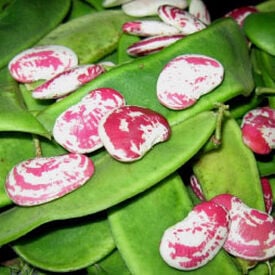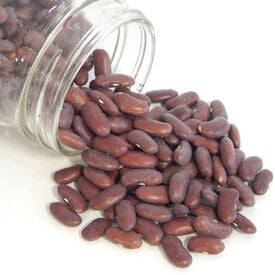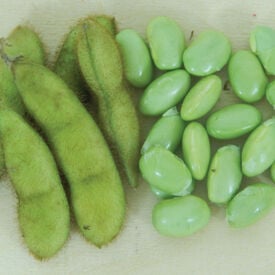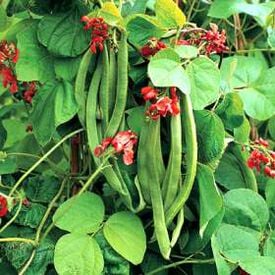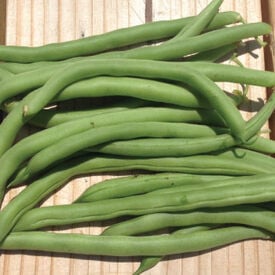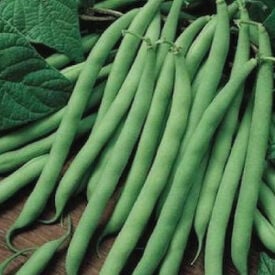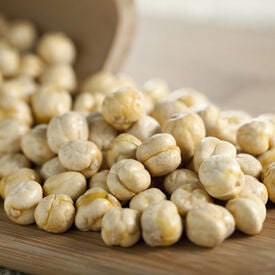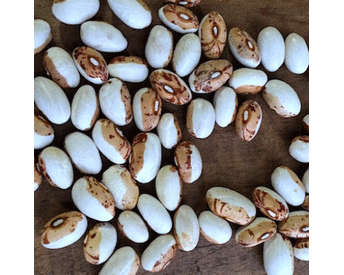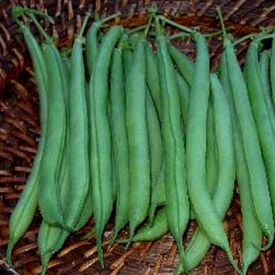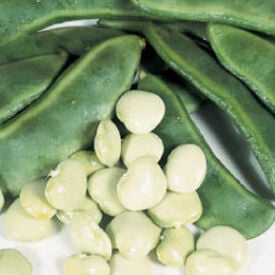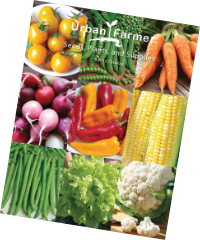Learn More
Christmas bean, scientifically known as Phaseolus vulgaris 'Christmas,' is a delightful and unique variety of green bean that adds a festive touch to holiday meals. This particular bean cultivar has a fascinating history dating back to the early 20th century when it was first developed by dedicated plant breeders. Its name, "Christmas bean," is derived from its vibrant red and green coloration, reminiscent of traditional holiday colors. In terms of taste, Christmas beans are known for their tender and crisp texture, making them a delightful addition to a variety of dishes. Their flavor is mildly sweet with a subtle nuttiness, making them a versatile choice for both cooking and salads. The beans typically mature in about 80 to 90 days, making them a relatively quick-growing option for gardeners. The pod size is medium to large, with an average length of 6-7 inches, perfect for harvesting when they are young and tender. Christmas bean plants need staked and can grow up 10' and higher! They are known for their disease resistance, particularly against common bean diseases such as rust and bean mosaic virus. When properly cared for, Christmas bean plants can yield an abundant harvest, with each plant producing a substantial number of pods. For optimal growth, they require well-drained soil, full sun exposure, and regular watering. Plant spacing should be about 4-6 inches apart in rows, and they thrive in a variety of climates, making them a popular choice for gardeners looking to add a festive touch to their holiday season while enjoying a bountiful harvest of delicious, colorful beans.
Contender beans, scientifically known as Phaseolus vulgaris 'Contender,' are a popular variety of green snap beans that have a rich history and are prized by gardeners for their excellent flavor and productivity. Originating from the United States, Contender beans have been a favorite among home gardeners and commercial growers for many decades. This heirloom variety was first introduced in the 1940s and has since become a classic choice for those looking to cultivate delicious and reliable green beans. Contender beans typically produce uniform, straight pods that range in size from 6 to 7 inches (15 to 18 cm) in length. The pods are slender and tender, making them ideal for fresh consumption, canning, or freezing. The plants themselves are compact and bushy, reaching a height of about 18 to 24 inches (45 to 60 cm), which makes them well-suited for smaller garden spaces or container gardening. In terms of maturity, Contender beans are known for their relatively quick growth. They typically reach maturity in approximately 50 to 55 days after planting. These beans thrive in full sun and well-drained soil with good organic matter content. They are relatively easy to grow and require regular watering to maintain consistent soil moisture. Contender beans are a favorite among gardeners for their reliability, versatility, and the delectable taste of their tender green pods.
Dark Red Kidney beans are one of the most widely used beans in North America! Dark Red Kidney is a bush variety of dried bean. Each pod contains 5 large, red kidney shaped beans. If rain threatens before your beans are totally dry, pull the whole plant up, hang upside down in your barn/garage to let them finish drying. Once dry, these beans will store for a long time! This bean is often used in Mexican food.A perfect winter food full of protein straight from your own garden.
The delicious buttery flavor of the Golden Wax Bush Bean make it a favorite among home gardeners! The stringless bright yellow pods are resistant common bean mosaic virus. The plant can produce pods 5-6 inches long. The Golden Wax beans are wonderful for canning, freezing and as a dry shell bean!
Envy is an early harvesting edamame for shorter growing seasons. Envy produces erect bush bean plants that reach about two feet in height and produce pods each containing two to three green seeds. Edamame is a popular snack in Japan, served with beer. Due to its health benefits that other snacks do not provide, it is becoming popular in the United States.
Scarlet Runner beans are a striking heirloom variety with a rich history that traces back to indigenous cultures in Central and South America. Introduced to Europe in the 17th century, these beans quickly gained popularity for both their ornamental beauty and culinary qualities. Characterized by their vigorous growth habit, Scarlet Runner plants can climb up to 10 feet or more, making them ideal for trellises or fences. The most notable feature of this variety is its vibrant scarlet flowers, which attract pollinators and add a stunning visual appeal to gardens. The pods are long and flat, typically green, maturing to a reddish hue, and are best harvested while still young and tender. Known for their rich, earthy flavor and creamy texture, Scarlet Runner beans are delicious in a variety of dishes, from stews to salads. Harvesting usually occurs in late summer to early fall, ensuring that the beans are picked before they dry out. With their ornamental charm, exceptional taste, and high productivity, Scarlet Runner beans remain a beloved choice for gardeners looking to combine beauty with culinary excellence.
Blue Lake 274 is a popular variety of green bean (Phaseolus vulgaris) known for its exceptional taste and reliable performance in home gardens and commercial agriculture. This cultivar has a rich history, tracing its origins back to the Blue Lake region in California. Blue Lake 274 beans are beloved for their tender, crisp texture and sweet, earthy flavor, making them a favorite among gardeners and consumers alike. The Blue Lake 274 bean plant typically grows to a height of 18 to 24 inches, with a bushy, compact habit that makes it suitable for both garden beds and containers. It is classified as a bush bean, which means it doesn't require trellising or support structures. This variety is known for its relatively quick maturity, typically taking about 55 to 60 days from planting to harvest. The pods of Blue Lake 274 are long and slender, usually reaching a length of 6 to 7 inches. They are a vibrant green color and are prized for their straightness and uniformity. Blue Lake 274 beans exhibit resistance to common bean diseases such as bean mosaic virus and bean common mosaic virus, which contributes to their reliability and yield consistency. Speaking of yield, you can expect a bountiful harvest from this variety, with each row typically producing around 8 to 10 pounds of beans. For optimal growth, Blue Lake 274 beans thrive in well-drained, fertile soil with a pH level of 6.0 to 6.8. Plant them in rows with spacing of approximately 18 to 24 inches between plants. They require full sun exposure for at least 6 to 8 hours a day and should be watered consistently to keep the soil evenly moist. With the right care and conditions, Blue Lake 274 beans are sure to provide a delicious and productive addition to your garden.
Chivo Blanco beans (Frijol Chivo Blanco) are a cherished heirloom variety native to Mexico, known for their small, white, and slightly oval-shaped beans. These beans are valued for their creamy texture and delicate flavor, making them perfect for a wide range of traditional Mexican dishes such as soups, stews, and frijoles de la olla (beans in a pot). The name "Chivo Blanco" refers to their smooth, pale appearance, and they are often praised for their ability to cook quickly and absorb seasonings well. Grown primarily in the central and southern regions of Mexico, Chivo Blanco beans are resilient to various growing conditions, thriving in both temperate and semi-arid climates. As an open-pollinated variety, they are ideal for sustainable farming and seed-saving, helping to preserve the rich agricultural heritage of Mexico while offering a reliable, nutritious source of protein for many households.
Elegance beans are a refined and attractive variety of pole beans, known for their impressive combination of visual appeal and superb flavor. These beans produce long, slender pods that typically measure 6 to 8 inches in length, featuring a rich green color and a smooth, glossy texture. The plants are characterized by their vigorous growth and high productivity, with a climbing habit that benefits from sturdy supports like trellises or poles. Elegance beans are renowned for their tender, crisp texture and mildly sweet taste, making them ideal for fresh eating, steaming, or sautéing. They are also noted for their disease resistance and adaptability to various growing conditions, thriving in full sun and well-drained soil. With their elegant appearance and exceptional culinary qualities, Elegance beans are a popular choice among gardeners looking to add both beauty and flavor to their harvest.
The Blue Lake FM-1K Pole is a stringless pole bean that is very tasty! Blue Lake beans are known for reliability, disease resistance, flavor and high yields. This is the pole version of the popular bush type that is widely planted for the canning industry. These bright green beans are straight and reach up to 7'. Perfect for those who are tired of bending over to pick beans, but still want the high yield of a bush bean.
Garbanzo beans are great for making homemade hummus. This unique heirloom variety produces delicious beans. Perfect for hummus and other Middle Eastern dishes. Also great for sprouting as well. Grow for a week and eat entire plant. Very nutritious! Contains vitamin A, C, calcium, iron and magnesium. Also known as chickpea. If using for sprouting they will be ready in 3-5 days.
The Hidatsa Shield bean, an heirloom variety with deep cultural roots, traces its origins to the Hidatsa people of the northern Great Plains in the United States. This ancient cultivar was cherished for its hardiness and flavor, embodying a vital part of the Hidatsa diet for centuries. The bean is named for its distinctive shield-shaped markings, which can range from mottled browns and reds to purples, giving it a striking appearance. Its flavor profile is noted for a rich, nutty taste with a creamy texture, making it a favored choice in various traditional dishes. The plant itself is a vigorous climber, known for its adaptability to different soil types and growing conditions. It typically blooms in mid-summer, producing small, pale flowers before setting pods that are ready for harvest in late summer or early fall. The Hidatsa Shield bean's resilience and ease of cultivation, coupled with its historical significance, continue to make it a valued crop among gardeners and food enthusiasts.
Seychelles beans are a vibrant and unique variety of green beans, renowned for their striking appearance and exceptional flavor. These beans are characterized by their slender, bright green pods, which typically grow to around 5 to 6 inches in length. The plants are known for their vigorous, climbing growth habit, making them ideal for vertical gardening with the support of trellises or poles. Seychelles beans are praised for their crisp, tender texture and slightly sweet, fresh taste, which enhances a variety of dishes from salads to stir-fries. They thrive in warm weather and full sun, growing rapidly and producing a bountiful harvest. Additionally, Seychelles beans are noted for their resilience and ability to adapt to different soil conditions, ensuring consistent and reliable yields. Their distinctive look and delicious flavor make Seychelles beans a standout choice for gardeners looking to add both beauty and taste to their vegetable gardens. All American Selection winner. Seychelles bean plants typically reach a height of 6 to 8 feet, making them well-suited for climbing and requiring support from trellises or poles. They are a productive variety, with a relatively quick turnaround from planting to harvest. The beans usually mature in about 55 to 60 days from sowing, providing a bountiful and consistent crop in a relatively short growing period. This combination of height and fast maturity makes Seychelles beans an excellent choice for gardeners looking to maximize space and enjoy a swift harvest.
Strike beans are one of the heaviest yielding bush beans on the market. Continuous setting feature protects grower from stress, better than concentrated set types. Medium green, 5" round pod with good disease tolerance. Excellent flavor that is very popular with commercial growers.
Henderson Lima beans, often referred to as Henderson's Bush Beans, are a renowned heirloom variety with a rich history and notable characteristics. Originating in the early 20th century, these beans were developed by the Henderson Seed Company, a notable seed supplier based in the United States. Henderson beans are appreciated for their compact, bushy growth habit, making them well-suited for smaller gardens or container planting. The plants typically reach about 18 to 24 inches in height, which allows for easy management and harvesting without the need for extensive staking or trellising. The beans are characterized by their smooth, green pods and are known for their tender texture and sweet, mild flavor. The pods are generally harvested when they are young and firm, usually in mid to late summer, to ensure the best taste and quality. Henderson beans are valued for their consistent productivity and disease resistance, which contribute to a reliable harvest. With their appealing flavor, compact growth habit, and dependable performance, Henderson beans remain a popular choice among home gardeners seeking a high-quality, easy-to-grow bean variety.
Bayo beans (Frijol Bayo) are a popular heirloom variety in Mexican cuisine, known for their creamy texture and mild, earthy flavor. These small, tan-colored beans with subtle speckling are prized for their versatility, often used in a variety of dishes like soups, stews, and refried beans. Their smooth consistency when cooked makes them ideal for creating hearty, comforting meals, and they hold up well in both traditional Mexican fare and more contemporary recipes. Bayo beans thrive in warm climates with well-drained soil and are particularly appreciated for their drought tolerance and resilience in the field. As an open-pollinated variety, Bayo beans are excellent for sustainable farming practices and seed-saving, allowing farmers and gardeners to preserve this rich agricultural tradition. These beans are not only a staple in many homes but also an essential part of Mexico’s agricultural and culinary heritage.
Accelerate beans are a fast-growing and highly productive variety of bush beans, celebrated for their exceptional speed to harvest and reliable performance. These beans are distinguished by their compact, bushy growth habit, which typically reaches 18 to 24 inches in height, making them well-suited for smaller gardens and container gardening. The plants produce uniform, tender pods that are usually 4 to 5 inches long, with a smooth, vibrant green color. Accelerate beans are known for their sweet, crisp texture and excellent flavor, making them ideal for fresh eating, stir-fries, or steaming. Their quick maturity, often within 50 to 55 days from planting, allows for multiple harvests within a single growing season. Additionally, Accelerate beans are praised for their resilience and adaptability to various soil conditions and weather, ensuring a bountiful and consistent crop. Their rapid growth and flavorful pods make them a favorite among gardeners seeking both efficiency and taste in their bean harvest.
Python beans are a distinctive and versatile variety of pole beans, celebrated for their unique appearance and robust flavor. Named for their long, slender pods, which can reach up to 23" inches in length, Python beans offer an impressive visual appeal with their vibrant green color and smooth texture. The plants exhibit a vigorous climbing habit, often requiring sturdy trellises or poles for support as they grow to heights of 6 to 8 feet. Python beans are known for their crisp, tender pods and slightly sweet taste, making them an excellent choice for fresh eating, sautéing, or adding to various dishes. They are also prized for their resilience and adaptability, thriving in a range of soil types and weather conditions. With a maturity period of about 70 to 80 days, Python beans provide a reliable and attractive harvest, enhancing both the beauty and flavor of any vegetable garden.
